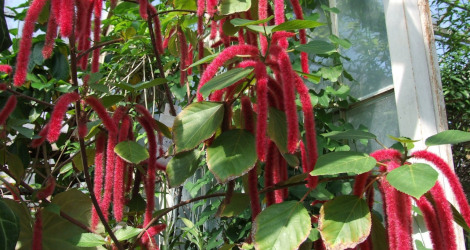Accession Data:
Acalypha hispida Burm. f.
- Common Name: Chenille Plant
- Family: Euphorbiaceae Juss.
- Description: Showy tropical shrub with broad ovate, bright green, hairy leaves with crenate margins' bright red flowers in long, pendant spikes resembling foxtails. Tropical climate.
- Uses: Traditional Folk Medicine:
- In indonesia, a root and flower decoction is used for hemoptysis. Leaf poultice used for leprosy.
- In Malaya, decoction of leaves and flowers taken internally as laxative and diuretic for gonorrhea. Bark used as expectorant and for asthma.
- In Africa, bark root used for pulmonary problems; leaf for leprosy, and flower for kidney ailments and as diuretic.
- Antimicrobial: Studies of leaf extracts isolated gallic aicd, corilagin and geranin responsible for antimicrobial activity.
- Trypanocidal: Aequous extract of Acalypha hispida leaves suggest trypanocidal effect.
- Anti-ulcer / Anti-tumor: Studies yielded geraniin and dehydroellagitannins which suggest diverse biological properties including anti-ulcer and anti-tumor effects, antibacterial activity against helicobacter pylori and antifungal activity.
- Phytochemicals: Phytochemical studies yield phenolics, flavonoids, hydroxyanthraquinones and saponins. It also detected steroids , phlobatannins and glycosides.
- Anthocyanins: Study isolated three anthocyanins from the red flowers of the chenille plant.
- IMPORTANT NOTE: Plant Uses are for informational purposes only. EEB Greenhouses assume no responsibility for adverse effects from the use of any plants referred to on this site. Always seek advice from a professional before using any plant medicinally.
- USDA Zone: 10a-11
Accession Data:
- Accession # 198500271
- Source: Unknown
- Accession Date: 12-31-1985
- Bench: 1211 - AUS:Ground Bed 1 SW
- Currently: active - healthy
- Qty: 3 confirmed on 07-01-2025
- Restrictions:
- Poisonous Plant Parts - Not for Human Consumption
Ingestion of these plants may cause minor illnesses such as vomiting or diarrhea.
- Poisonous Plant Parts - Not for Human Consumption
Classification:
- Division: Magnoliophyta
- Class: Magnoliopsida
- SubClass: eurosid I
- Order: Malpighiales
- SubOrder:
- Family: Euphorbiaceae
- SubFamily: Acalyphoideae
- Tribe: Acalypheae
- SubTribe: Acalyphinae
Flowering Data:
This accession has been observed in bloom on:| Year | Jan | Feb | Mar | Apr | May | Jun | Jul | Aug | Sep | Oct | Nov | Dec | ||||||||||||||||||||||||||||||||||||||||
|---|---|---|---|---|---|---|---|---|---|---|---|---|---|---|---|---|---|---|---|---|---|---|---|---|---|---|---|---|---|---|---|---|---|---|---|---|---|---|---|---|---|---|---|---|---|---|---|---|---|---|---|---|
| 2025 | ||||||||||||||||||||||||||||||||||||||||||||||||||||
| 2024 | ||||||||||||||||||||||||||||||||||||||||||||||||||||
| 2023 | ||||||||||||||||||||||||||||||||||||||||||||||||||||
| 2022 | ||||||||||||||||||||||||||||||||||||||||||||||||||||
| 2021 | ||||||||||||||||||||||||||||||||||||||||||||||||||||
| 2020 | ||||||||||||||||||||||||||||||||||||||||||||||||||||
| 2019 | ||||||||||||||||||||||||||||||||||||||||||||||||||||
| 2018 | ||||||||||||||||||||||||||||||||||||||||||||||||||||
| 2017 | ||||||||||||||||||||||||||||||||||||||||||||||||||||
| 2016 | ||||||||||||||||||||||||||||||||||||||||||||||||||||
| 2015 | ||||||||||||||||||||||||||||||||||||||||||||||||||||
| 2014 | ||||||||||||||||||||||||||||||||||||||||||||||||||||
| 2013 | ||||||||||||||||||||||||||||||||||||||||||||||||||||
| 2012 | ||||||||||||||||||||||||||||||||||||||||||||||||||||
| 2011 | ||||||||||||||||||||||||||||||||||||||||||||||||||||
| 2010 | ||||||||||||||||||||||||||||||||||||||||||||||||||||
| 2009 | ||||||||||||||||||||||||||||||||||||||||||||||||||||
| 2008 | ||||||||||||||||||||||||||||||||||||||||||||||||||||
| 2007 | ||||||||||||||||||||||||||||||||||||||||||||||||||||
| 2006 | ||||||||||||||||||||||||||||||||||||||||||||||||||||
| 2005 | ||||||||||||||||||||||||||||||||||||||||||||||||||||
| 2004 | ||||||||||||||||||||||||||||||||||||||||||||||||||||
References (internal):
- EEB Greenhouse Holdings native to: Bismarck Archipelago /
References (external):
- Exotica by A.B.Graf
- The Plant List (2013). Version 1.1. Accessed 19 May 2015.
- WCSP (2015). World Checklist of Selected Plant Families. Facilitated by the Royal Botanic Gardens, Kew. Accessed 19 May 2015
- Poisonous Plants at University of California. Last accessed on Wednesday, July 05, 2017.
- Chenille Plant at Philippine Alternative Medicine. Last accessed Wednesday, 12 December, 2018.
- Image #00 (cropped) & #03 (original) by Jerzy Opiola [GFDL or CC BY 3.0], from Wikimedia Commons. Last accessed Wednesday, 12 December, 2018.
data regenerated on Wed, 02 Jul 2025 15:51:05 -0400 [bcm v4.0]
Images:

Additional images for this accession:
Click on thumbnails to enlargeCurrent Accessions in the Euphorbiaceae
Subfamily Acalyphoideae
Tribe Acalypheae
- Acalyphinae: Acalypha chamaedrifolia



- Acalyphinae: Acalypha hispida



- Acalyphinae: Acalypha wilkesiana `Macafeana'


- Ricininae: Ricinus communis


Subfamily Acalyphoideae
Tribe Plukenetieae
- Dalechampiinae: Dalechampia spathulata



Subfamily Crotonoideae
Tribe Aleuritideae
- Aleuritinae: Aleurites moluccanus

- Garciinae: Garcia nutans

Subfamily Crotonoideae
Tribe Codiaeae
Subfamily Crotonoideae
Tribe Crotoneae
Subfamily Crotonoideae
Tribe Jatropheae
Subfamily Crotonoideae
Tribe Manihoteae
Subfamily Crotonoideae
Tribe Micrandreae
- Heveinae: Hevea brasiliensis

Subfamily Euphorbioideae
Tribe Euphorbieae
- Euphorbiinae: Euphorbia abyssinica

- Euphorbiinae: Euphorbia aeruginosa

- Euphorbiinae: Euphorbia alluaudii ssp. oncoclada

- Euphorbiinae: Euphorbia antiquorum

- Euphorbiinae: Euphorbia antisyphilitica

- Euphorbiinae: Euphorbia baioensis

- Euphorbiinae: Euphorbia beharensis var. guillemetii

- Euphorbiinae: Euphorbia bicompacta

- Euphorbiinae: Euphorbia bicompacta var. rubra

- Euphorbiinae: Euphorbia bupleurifolia

- Euphorbiinae: Euphorbia bupleurifolia x susannae
- Euphorbiinae: Euphorbia caerulescens

- Euphorbiinae: Euphorbia canariensis

- Euphorbiinae: Euphorbia caput-medusae

- Euphorbiinae: Euphorbia clandestina
- Euphorbiinae: Euphorbia croizatii

- Euphorbiinae: Euphorbia cylindrifolia

- Euphorbiinae: Euphorbia decaryi


- Euphorbiinae: Euphorbia didiereoides


- Euphorbiinae: Euphorbia enterophora

- Euphorbiinae: Euphorbia francoisii


- Euphorbiinae: Euphorbia globosa W/C

- Euphorbiinae: Euphorbia greenwayi var. greenwayi


- Euphorbiinae: Euphorbia guiengola



- Euphorbiinae: Euphorbia knuthii

- Euphorbiinae: Euphorbia lactea

- Euphorbiinae: Euphorbia leuconeura



- Euphorbiinae: Euphorbia lomelii
- Euphorbiinae: Euphorbia magnifica

- Euphorbiinae: Euphorbia mammillaris


- Euphorbiinae: Euphorbia mauritanica

- Euphorbiinae: Euphorbia milii var. splendens

- Euphorbiinae: Euphorbia neriifolia

- Euphorbiinae: Euphorbia obesa

- Euphorbiinae: Euphorbia obesa ssp. obesa


- Euphorbiinae: Euphorbia platyclada

- Euphorbiinae: Euphorbia polygona cv. 'Snowflake'
- Euphorbiinae: Euphorbia pseudoglobosa

- Euphorbiinae: Euphorbia resinifera

- Euphorbiinae: Euphorbia ritchiei subsp. ritchiei

- Euphorbiinae: Euphorbia stenoclada

- Euphorbiinae: Euphorbia susannae

- Euphorbiinae: Euphorbia tetracanthoides

- Euphorbiinae: Euphorbia tirucalli

- Euphorbiinae: Euphorbia trigona

- Euphorbiinae: Euphorbia virosa ssp. virosa

 = indicates flowering in past 14 days
= indicates flowering in past 14 days
 = images available for this accession
= images available for this accession
 = map available for this accession
= map available for this accession
 = accession added within past 90 days
= accession added within past 90 days



